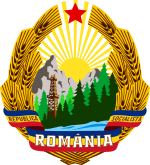Bărăgan deportations
This article includes a list of general references, but it lacks sufficient corresponding inline citations. (May 2018) |

| Part of a series on the |
| Socialist Republic of Romania |
|---|
 |
The Bărăgan deportations (Romanian: Deportările în Bărăgan) were a large-scale action of penal transportation, undertaken during the 1950s by the Romanian Communist regime. Their aim was to forcibly relocate individuals who lived within approximately 25 km (15 miles) of the Yugoslav border (in present-day Timiș, Caraș-Severin, and Mehedinți counties) to the Bărăgan Plain. The deportees were allowed to return after 1956.
Reasons
After relations deteriorated between Romania and Yugoslavia, which was excluded from the
The Ministry of Interior will be able, through a decision, to order the removal from population centres of any persons whose presence in those centres is unjustified, as well as the removal of those from any locality who, through their actions before the working people, endanger the construction of socialism in the Romanian People's Republic. For those in question obligatory residences can be set up in any locality.
The decree created favourable conditions for the implementation of the previously-planned deportations. This was to be the second mass deportation following the overthrow of Ion Antonescu, after the January 1945 deportation of over 30,000 ethnic Germans to the Soviet Union, during the closing stages of World War II (the deportees gradually returned between 1945 and 1952). In contrast to the first deportation, this time, the destination was the Bărăgan Plain, an underdeveloped, sparsely populated area. In a sense, the operation also served as a means of colonizing the region.
The plans allegedly involved, as was later discovered in a document written in
Events


During the night of June 18, 1951, the third-largest mass deportation in modern Romanian history took place, surpassed only by the World War II deportation of
The deportees were taken under military guard and left to build houses of mud or adobe on their own in eighteen localities. In 1956, a change in government policy meant that the majority of deportees returned home, but some chose to stay permanently in the Bărăgan Plain.
References
- ^ Glasnik HDZ, 1991
- ISBN 978-3-319-32379-4.
- Elena Spijavca, Munci și zile în Bărăgan (Works and Days on the Bărăgan), 2004, Editura Fundația Academică Civică, ISBN 973-8214-23-8
- Rafael Mirciov, Lagărul deportării – Pagini din lagărul Bărăganului (The Deportations Camps – Pages from the Bărăgan Camp)
- Silvestru Ștevin, Desculț prin propriul destin (Barefoot through My Own Destiny), Editura Mirton, Timișoara, 2002
- Silviu Sarafolean, Deportații în Bărăgan 1951–1956 (The Bărăgan Deportations, 1951–1956)
- Viorel Marineasa, Daniel Vighi, Rusalii ’51 – fragmente din deportarea în Bărăgan (Pentecost '51 – Fragments from the Bărăgan Deportations)
- Viorel Marineasa, Daniel Vighi, Valentin Sămînță, Deportarea în Bărăgan – Destine, documente, reportaje (The Bărăgan Deportations – Destinies, Documents, Reportages)
External links
- (in Romanian) Association of Former Bărăgan Deportees – Timișoara
- "Sighet Museum: Room 47 – Deportations to Bărăgan". www.memorialsighet.ro. The Memorial of the Victims of Communism and of the Resistance. 11 October 2015. Retrieved July 22, 2020.
- "Deportați in Bărăgan" [Deported to the Bărăgan]. Ziua (in Romanian). Retrieved July 22, 2020.
- Smaranda Vultur (June 23, 2006). "Din istoria unei memorii, Bărăgan 1951–1956" [From the History of a Memory, Bărăgan 1951–1956]. Revista 22 (in Romanian). Archived from the original on 2006-07-19. Retrieved July 22, 2020.
- Gerhard Binder (June 2005). "De sărbătoarea Rusaliilor s-a împlinit mai bine de jumătate de veac de la pribegia în Bărăgan" [It has been more than half a century since the exile in the Bărăgan] (in Romanian). Agenda – Timișoara. Archived from the original on 2006-02-06. Retrieved July 22, 2020.
- ""Igienizarea" din Banat" [The "Purification" of the Banat]. Evenimentul Zilei (in Romanian). February 25, 2006. Archived from the original on 2007-03-13. Retrieved July 22, 2020.
- (in Romanian) Map of the Romanian Gulag (pdf)
- (in English) Donauschwaben Villages Helping Hands – Deportation to the Bărăgan
- Walther Konschitzky; Peter-Dietmar Leber; Walter Wolf (2001). "Deported to the Bărăgan 1951–1956". www.dvhh.org. Munchen: Haus des Deutschen Ostens. Retrieved July 22, 2020.
